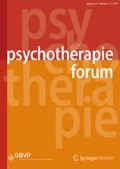Summary
In this article a connection is made between "agency" (an altruistic, object-related coping strategy) and burnout. In doing so, the author first describes the characteristics of "agency" in detail, delineating its course from being a developmental task while learning to bond to becoming a tool for mastering this task – in the attempt to improve attachment to one's mother – through forced object orientation. The author then proposes the hypothesis that as an object-related coping strategy "agency" works especially well for coping with two out of the four developmental tasks; that, however, owing to frustration or self-exploitation and loss of energy, "agency" will sooner or later turn into a self-related coping strategy. Through her article, the author makes visible the connections between J. Rosenberg's body psychotherapy, the principles of the structural approach to self development (Rudolf), attachment research and neurobiology (Hüther) as well as the Polyvagal Theory of the autonomic nervous system (Porges).
Zusammenfassung
Die Autorin stellt einen Zusammenhang her zwischen der objektbezogenen Bewältigungsstrategie "Agency" (Rosenberg), dem altruistischen Bewältigungsmodus (Rudolf) und Burnout. Dabei beschreibt sie eingehend die Phänomene von "Agency", zeigt den Weg von der Entwicklungsaufgabe im Laufe der Bindungsentwicklung zur Bewältigung der Aufgabe durch eine forcierte Objektorientierung als Versuch für eine verbesserte Bindungsgestaltung zur Mutter. Sie stellt die These auf, dass sich dieser objektbezogene Bewältigungsmodus zur "Bewältigung" von zwei der vier Entwicklungsaufgaben speziell gut eignet. Durch Enttäuschung oder durch Selbstausbeutung und Kräftemangel kippt dieser Modus früher oder später in Selbstbezogenheit. Deutlich werden Brücken dargestellt zwischen der Körperpsychotherapie von J. Rosenberg, den Grundlagen einer strukturellen Sicht der Selbstentwicklung (Rudolf), der Bindungsforschung und der Neurobiologie (Hüther) sowie der Polyvagalen Theorie des autonomen Nervensystems (Porges).
Similar content being viewed by others
Literatur
Arbeitskreis OPD (Hrsg) (2006) Operationalisierte Psychodynamische Diagnostik OPD 2. Hans Huber, Bern
Buser-Kaufmann* R (1999) Objektbezogenheit und Selbstbezogenheit als Abwehr. Oder: Agency und defensiver Charakterstil. In: Energie und Charakter. Heiden (*heute: Kaufmann Gunz R)
Grossmann K, Grossmann K (2004, 2. Aufl. 2005) Bindung – das Gefüge psychischer Sicherheit. Klett-Cotta, Stuttgart
Hentschel K (2004) Multiaxiale Diagnostik in der Körperpsychotherapie. Das "Charakter Cube Model" – Ein Struktur–Prozess-Dynamik(SPD)-orientiertes Kubusmodell zur Diagnostik Charakterologischer Anpassungsprozesse. Niederweningen
Hüther G (1999) Biologie der Angst. Wie aus Stress Gefühle werden. 3. Aufl. Vandenhoeck & Ruprecht, Göttingen
Hüther G (2001) Bedienungsanleitung für ein menschliches Gehirn. Vandenhoeck & Ruprecht, Göttingen
Kaufmann Gunz R (2002) Narcissus and Echo. When Narcissus Gazes into the Clear Spring. In: Celebrating a Master Psychotherapist: Jack Lee Rosenberg. A Festschrift in Honor of his 70th Birthday. Ibp-books, St. Gallen, S. 215-234 Deutsch: Narziss und Echo. Wenn Narziss in die klare Quelle blickt. www.kompetenzentwicklung.ch. Boppelsen/CH
Kaufmann Gunz R (2005) Polyvagale Theorie und Psychotherapie. www.kompetenzentwicklung.ch. Watt-Regensdorf
Kaufmann Gunz R (2006) Bindung und psychische Sicherheit. Masterthese zur Erlangung des MSc in psychotherapeutischer Psychologie. Zentrum für Psychosoziale Medizin, Donau Universität Krems
Kaufmann Gunz R (2010) "Agency"-Charakteristiken. www.kompetenzentwicklung.ch Watt-Regensdorf
Mentzos S (1995) Depression und Manie. Vandenhoeck & Ruprecht, Göttingen Zürich
Porges S (2001) The polyvagal theory: phylogenetic substrates of a social nervous system. ELSEVIER International Journal of Psychophysiology 42: 123–146
Porges S (2006) Neuroception – Ein "unterbewusstes" System zur Wahrnehmung von Bedrohung und Sicherheit. In: Remmel A, Kernberg O, Vollmoeller W, Strauß B (Hrsg) Handbuch Körper und Persönlichkeit. Entwicklungspsychologie, Neurobiologie und Therapie von Persönlichkeitsstörungen. Schattauer, Stuttgart
Porges S (2007) Seminar: Polyvagale Theorie. Zürich
Rosenberg J, Kitaen Morse B (1996) The intimate couple. Reaching new levels of sexual excitement through body awakening and relationship renewal. Turner Publishing, Atlanta
Rudolf G (2004, 2. Auflage 2006) Struktur-bezogene Psychotherapie. Leitfaden zur psychodynamischen Therapie struktureller Störungen. Schattauer, Stuttgart
Rudolf G (2010) Psychodynamische Psychotherapie. Die Arbeit an Konflikt, Struktur und Trauma. Schattauer, Stuttgart
Author information
Authors and Affiliations
Corresponding author
About this article
Cite this article
Kaufmann Gunz, R. "Ich tue alles für dich, aber verlasse mich nicht!" Burnout und "Agency". Psychotherapie Forum 18, 174–182 (2010). https://doi.org/10.1007/s00729-010-0337-7
Issue Date:
DOI: https://doi.org/10.1007/s00729-010-0337-7
Keywords
- Agency
- Object-related coping strategy
- Character style
- Self-related coping strategy
- Neglect of self-interests
- Self-regulation
- Relational regulation
- Mentalization
- Conflict
- Structure
- Trauma




